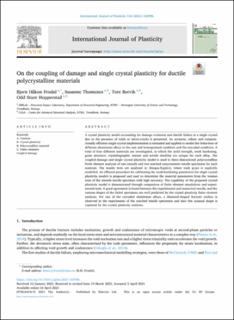| dc.contributor.author | Frodal, Bjørn Håkon | |
| dc.contributor.author | Thomesen, Susanne | |
| dc.contributor.author | Børvik, Tore | |
| dc.contributor.author | Hopperstad, Odd Sture | |
| dc.date.accessioned | 2021-06-10T07:48:57Z | |
| dc.date.available | 2021-06-10T07:48:57Z | |
| dc.date.created | 2021-06-09T09:46:57Z | |
| dc.date.issued | 2021 | |
| dc.identifier.citation | International journal of plasticity. 2021, 142, . | en_US |
| dc.identifier.issn | 0749-6419 | |
| dc.identifier.uri | https://hdl.handle.net/11250/2758760 | |
| dc.description.abstract | A crystal plasticity model accounting for damage evolution and ductile failure in a single crystal due to the presence of voids or micro-cracks is presented. An accurate, robust and computationally efficient single crystal implementation is extended and applied to model the behaviour of different aluminium alloys in the cast and homogenized condition and the extruded condition. A total of four different materials are investigated, in which the yield strength, work hardening, grain structure, crystallographic texture and tensile ductility are unique for each alloy. The coupled damage and single crystal plasticity model is used in three-dimensional polycrystalline finite element analyses of one smooth and two notched axisymmetric tensile specimens for each material. The tensile tests are analysed in Abaqus/Explicit, where each grain is explicitly modelled. An efficient procedure for calibrating the work-hardening parameters for single crystal plasticity models is proposed and used to determine the material parameters from the tension tests of the smooth tensile specimen with high accuracy. The capability of the proposed crystal plasticity model is demonstrated through comparison of finite element simulations and experimental tests. A good agreement is found between the experimental and numerical results, and the various shapes of the failed specimens are well predicted by the crystal plasticity finite element analyses. For one of the extruded aluminium alloys, a diamond-shaped fracture surface is observed in the experiments of the notched tensile specimens and also this unusual shape is captured by the crystal plasticity analyses. | en_US |
| dc.language.iso | eng | en_US |
| dc.publisher | Elsevier Ltd. | en_US |
| dc.relation.uri | https://doi.org/10.1016/j.ijplas.2021.102996 | |
| dc.rights | Navngivelse 4.0 Internasjonal | * |
| dc.rights.uri | http://creativecommons.org/licenses/by/4.0/deed.no | * |
| dc.title | On the coupling of damage and single crystal plasticity for ductile polycrystalline materials | en_US |
| dc.type | Peer reviewed | en_US |
| dc.type | Journal article | en_US |
| dc.description.version | publishedVersion | en_US |
| dc.source.volume | 142 | en_US |
| dc.source.journal | International journal of plasticity | en_US |
| dc.identifier.doi | https://doi.org/10.1016/j.ijplas.2021.102996 | |
| dc.identifier.cristin | 1914732 | |
| dc.relation.project | Norges forskningsråd: 250553 | en_US |
| dc.description.localcode | This is an open access article distributed under the terms of the Creative Commons CC-BY license, which permits unrestricted use, distribution, and reproduction in any medium, provided the original work is properly cited. | en_US |
| dc.source.articlenumber | 102996 | en_US |
| cristin.ispublished | true | |
| cristin.fulltext | original | |
| cristin.qualitycode | 2 | |

